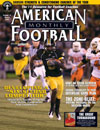Article CategoriesAFM Magazine
|
Developing Quickness in Your Players Part Iby: Dale BaskettFootball Speed Specialist © More from this issue All coaches recognize quickness when they see it but don’t usually understand how to develop it. As coaches we will inherit certain kids with quickness skills. The question is to what degree can quickness be developed. The answer – to the level of potential of each athlete. Not every athlete will be as capable as the next but each will get better if the right training applications are involved. Beyond the Fallacy We begin by challenging coaches’ belief that natural ability alone leads to team quickness. Improving the skill of human movement is accomplished by the application of technical and physical training. However, we must first realize that all quickness movement is a by-product of genetics. Fast-twitch fiber is genetically inherited. Certain players possess higher ratios of fast-twit....The full article can only be seen by subscribers.
|
|
|||||||
| HOME |
MAGAZINE |
SUBSCRIBE | ONLINE COLUMNISTS | COACHING VIDEOS |
Copyright 2025, AmericanFootballMonthly.com
All Rights Reserved





